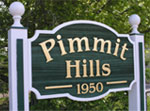VIENNA, Va. - Later this month, commuters will get a chance to talk to leaders about how to spend new transportation money to fix traffic congestion in Fairfax County.
With more than a million residents, Fairfax County is one of the biggest and most congested suburbs in our entire region. From the Fairfax County Parkway to Route 28, Route 123, Route 50, Route 29 and Route 1, there are no shortage of locations that could use some congestion relief.
"Reducing congestion is a very important piece of the puzzle, but it's not the only piece," says Fairfax County Transportation Director Tom Biesiadny. "I could come up with the best project in the world that relieves the most congestion and is the most cost effective, but if it runs through someone's backyard and the community doesn't support it, we're probably not going anywhere with that project."
Fairfax County is getting the new transportation money under the transportation bill passed in the General Assembly earlier this year. Under the law, each jurisdiction gets to keep 30 percent of the revenue generated within its borders from the new taxes, including a higher sales tax, and the Northern Virginia Transportation Authority (NVTA) will receive 70 percent of the funds. While it's unclear exactly how much money Fairfax County will raise in the first year, NVTA officials have said they believe the overall number will be about $280 million region wide.
Four meetings are scheduled across Fairfax County to talk about traffic problems and where the money should be allocated:
Wednesday, Oct. 30 - Hayfield Secondary School, 7630 Telegraph Road, Alexandria
Monday, Nov. 4 - Falls Church High School, 7521 Jaguar Trail, Falls Church
Tuesday, Nov. 12 - Fairfax County Government Center, 12000 Government Center Parkway, Fairfax
Wednesday, Nov. 13 - Forest Edge Elementary School, 1501 Becontree Lane, Reston
The meetings will have a similar format to those held earlier this year when Fairfax County unveiled changes to its Fairfax Connector routes. Each meeting will begin at 6:30 p.m. and include a presentation and a question and answer session with residents.
"We'll have an open house where there will be time to walk around and look at the projects, look at the detail on the maps and we'll do a presentation with question and answer and comments," says Biesiadny. "What we're trying to do is try and figure out where there is some consensus, where is there community support. We'll allow them a chance to give us their vote, so to speak, although we will not do a straight tally."
Biesiadny presented a list of about 200 unfunded roadway and transit projects during his speech before the Fairfax Committee of 100, each vying for a spot on the six-year transportation plan for the county. Most of the projects have a benefit-cost analysis ratio to help determine the best investment for the money.
"There is three factors that we've included in the benefit-cost analysis. We've included congestion reduction, travel time savings and air quality benefits. We could include 20 or 30 different measures, but that doesn't mean you'd get better results, you just spent more time. We wanted to keep it simple and we think these factors are a good barometer," he says.
Biesiadny says an average score for a project would be 1.0, which means the benefits from the three factors will pay for the project over 20 years. For projects with a score higher than 1.0, benefits from congestion reduction, travel time savings and air quality will pay off in less than 20 years. Lower than 1.0 means the benefits would take longer than 20 years to pay off the costs of the project.
"Our comprehensive plan, we have a number of interchanges and road widening projects that we've been unable to fund, particularly along the Fairfax County Parkway," he says.
A number of Fairfax County Parkway projects score very high on the benefit-cost ratio and could be ripe for funding, including intersection improvements at Popes Head Road and Braddock Road. Projects to widen the Fairfax County Parkway from Route 29 to Route 123 and from West Ox Road to the Dulles Toll Road from four to six lanes also scored highly on the benefit-cost analysis. In total, both projects would cost about $145 million to complete.
On transit, three projects received high marks for their benefit to congestion relief.
One would be $54 million to construct a 2,037-space garage at the Innovation Center Metrorail Station, due to open in phase two of the Silver Line project.
A second would be $47 million to purchase buses and improve bus service between the Herndon-Monroe Park-and-Ride and Fort Belvoir along the Fairfax County Parkway. With more than 30,000 employees commuting each day, Fort Belvoir is a major job center in Fairfax County that contributes a lot of traffic to roads like the Fairfax County Parkway and Route 1 (Richmond Highway).
Finally, a $116.5 million project to purchase buses and implement new cross-county express bus service between Vienna and Centreville also is being considered.
"In Fairfax County, most of our growth in the future is not going to occur in Great Falls or Clifton. It's mostly going to happen in our activity centers. So that is where we are going to looking to make transportation improvements," says Biesiadny.
After the public meetings wrap up, the Fairfax County Transportation Department will brief the Board of Supervisors in December. The Board of Supervisors will likely approve a six-year priority project list in January.
